The exercise was used by over 200 Soviet and Russian doctors who have been practicing the Buteyko breathing self-oxygenation method. They taught it to many thousands of people. The exercise helps, in most cases, to stop asthma attacks without using bronchodilators. (I translated many Russian medical papers.)
Practical actions
Sit down in any chair, couch, sofa or divan for better relaxation. If there are no objects to sit on, sit on the ground/floor, e.g. on your knees or with criss-crossed legs. Relax all your muscles. Focus on your breathing. It must be huge. Why? Numerous studies proved that asthmatics breathe 2-3 times more than the medical norm between the acute episodes. During attacks their breathing is even heavier. Symptoms of asthma are possible only when they breathe 3-5 times more air than the medical norm. You are breathing too much!
Focus on your breathing for a minute. What do you feel? If the sensations are vague, take a deep but slow in-breath and relax to slowly exhale. Do you feel the airflow going through your nostrils? Do you have any sensations at the back of your throat? Are there any feelings about movement of air inside the chest and bronchi? What do you sense near your stomach?
Next, hold your breath for about 3-4 s. You will get air hunger or desire to breathe more. After this, instead of taking your usual big inhalation, take a slightly smaller inhalation (only about 5-10% less than your usual inhalation) and then immediately relax all muscles, especially upper chest and all other breathing muscles. Take another (smaller) inhalation and again completely relax.
With each breath, take a small or reduced inhalation and then completely relax. Maintain air hunger. The goal is to preserve this comfortable level of air hunger for 2-3 minutes. The breathing can be frequent during this reduced or shallow breathing but this is OK. If you do the exercise correctly, you will notice that your chest tightness, wheezing, and other symptoms will disappear.
About your medication
If you cannot alleviate the upcoming attack in 5 minutes, Russian Buteyko doctors would suggest you to use 1/3 of your standard medication. After taking medication, repeat the breathing exercise monitoring the severity of the symptoms. If it is still not possible to stop an attack, again take 1/3 of your usual dose. Do the breathing exercise once more. Russian medical doctors and practitioners found that most patients could eliminate their symptoms in 1-5 minutes without using medication.
Breathing and asthma
Our breathing pattern has profound effects on all components of asthma.
First of all, heavy breathing, as in cases of all asthmatics, reduces body oxygenation. This simple fact is easy to check. Measure your stress-free breath holding time after exhalation. The test is very sensitive to body oxygen content. How is the test done? After your usual exhalation, pinch your nose and hold your breath only till the first stress or discomfort. When you finish the test and release your nose, you should be able to breathe as before the test. Normal breath holding time is about 40-60 s. People with mild asthma have about 15 s of oxygen. Severe asthmatics have even less. During asthma attacks it is only 5 s or less. This is the paradox of breathing: those people, who breathe heavy at rest, have less oxygen in tissues.
Second, CO2, the gas we exhale, is a bronchodilator. This is the reason why breathing less works.
Third, heavy breathing makes the immune system oversensitive. Various allergies can appear. Normalization of breathing creates conditions for normal work of the immune system.
Fourth, even if you avoid all triggers, it is impossible to heal airways in conditions of chronic over-breathing. Why? Because of tissue hypoxia, poor blood supply, and an abnormal state of the immune system.
If you retrain or normalize your breathing pattern, your body oxygenation will be improved. When you can comfortably hold your breath for 20 or more seconds, your asthma symptoms will disappear and no medication will be necessary. This clinical observation is based on experience of thousands of Soviet and Russian asthmatics who learned the Buteyko breathing method. This self-oxygenation therapy was developed by Soviet physiologist Dr. Konstantin Buteyko, MD. In the 1960s he led the scientific project for the first Soviet space missions and studied interactions involving breathing, air composition, and various diseases. The Buteyko method is approved by Russian Ministry of Health for treatment of asthma and heart disease.
Resources
Asthma Symptoms, Signs, Allergies, and Medication and effects of breathing retraining on these factors
Mouth Taping During Night Sleep - Buteyko technique to stop acute asthma at night Urge-To-Cough Mechanism Discovered - and How to stop coughing breathing technique.
NormalBreathing.com has hundreds of medical quotes with references, graphs and charts, tables, analysis of numerous respiration techniques, results of clinical trials, free breathing exercises, lifestyle modules, manuals, techniques, and other resources to boost cell and body oxygen levels and improve health.







